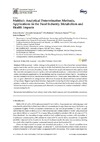Identificador persistente para citar o vincular este elemento:
https://accedacris.ulpgc.es/jspui/handle/10553/73798
| Campo DC | Valor | idioma |
|---|---|---|
| dc.contributor.author | Saraiva, Ariana | en_US |
| dc.contributor.author | Carrascosa Iruzubieta, Conrado Javier | en_US |
| dc.contributor.author | Raheem, Dele | en_US |
| dc.contributor.author | Ramos, Fernando | en_US |
| dc.contributor.author | Raposo, António | en_US |
| dc.date.accessioned | 2020-07-26T12:28:20Z | - |
| dc.date.available | 2020-07-26T12:28:20Z | - |
| dc.date.issued | 2020 | en_US |
| dc.identifier.issn | 1661-7827 | en_US |
| dc.identifier.other | Scopus | - |
| dc.identifier.uri | https://accedacris.ulpgc.es/handle/10553/73798 | - |
| dc.description.abstract | Bulk sweetener maltitol belongs to the polyols family and there have been several dietary applications in the past few years, during which the food industry has used it in many food products: bakery and dairy products, chocolate, sweets. This review paper addresses and discusses in detail the most relevant aspects concerning the analytical methods employed to determine maltitol’s food safety and industry applications, its metabolism and its impacts on human health. According to our main research outcome, we can assume that maltitol at lower doses poses little risk to humans and is a good alternative to using sucrose. However, it causes diarrhoea and foetus complications at high doses. Regarding its determination, high-performance liquid chromatography proved the primary method in various food matrices. The future role of maltitol in the food industry is likely to become more relevant as processors seek alternative sweeteners in product formulation without compromising health. | en_US |
| dc.language | eng | en_US |
| dc.relation.ispartof | International Journal of Environmental Research and Public Health | en_US |
| dc.source | International Journal of Environmental Research and Public Health [ISSN 1661-7827], v. 17 (14), 5227, (Julio 2020) | en_US |
| dc.subject | 3206 Ciencias de la nutrición | en_US |
| dc.subject.other | Food Additives | en_US |
| dc.subject.other | Food Industry | en_US |
| dc.subject.other | Food Safety | en_US |
| dc.subject.other | Health Impacts | en_US |
| dc.subject.other | Maltitol | en_US |
| dc.subject.other | Metabolism | en_US |
| dc.subject.other | Sweeteners | en_US |
| dc.title | Maltitol: Analytical determination methods, applications in the food industry, metabolism and health impacts | en_US |
| dc.type | info:eu-repo/semantics/review | en_US |
| dc.type | Review | en_US |
| dc.identifier.doi | 10.3390/ijerph17145227 | en_US |
| dc.identifier.scopus | 85088168137 | - |
| dc.contributor.authorscopusid | 57210467342 | - |
| dc.contributor.authorscopusid | 55243552300 | - |
| dc.contributor.authorscopusid | 15841846300 | - |
| dc.contributor.authorscopusid | 7102339610 | - |
| dc.contributor.authorscopusid | 55257860600 | - |
| dc.identifier.eissn | 1660-4601 | - |
| dc.description.lastpage | 28 | en_US |
| dc.identifier.issue | 14 | - |
| dc.description.firstpage | 1 | en_US |
| dc.relation.volume | 17 | en_US |
| dc.investigacion | Ciencias de la Salud | en_US |
| dc.type2 | Reseña | en_US |
| dc.description.notas | This article belongs to the Special Issue Food Safety, Security, Sustainability and Nutrition as Priority Objectives of the Food Sector | en_US |
| dc.utils.revision | Sí | en_US |
| dc.date.coverdate | Julio 2020 | en_US |
| dc.identifier.ulpgc | Sí | en_US |
| dc.identifier.ulpgc | Sí | en_US |
| dc.identifier.ulpgc | Sí | en_US |
| dc.identifier.ulpgc | Sí | en_US |
| dc.description.sjr | 0,747 | |
| dc.description.jcr | 3,39 | |
| dc.description.sjrq | Q2 | |
| dc.description.jcrq | Q1 | |
| dc.description.scie | SCIE | |
| dc.description.ssci | SSCI | |
| item.grantfulltext | open | - |
| item.fulltext | Con texto completo | - |
| crisitem.author.dept | GIR OHAPA (Higiene y Protección Alimentaria) Grupo de Investigación | - |
| crisitem.author.dept | Departamento de Patología Animal, Producción Animal, Bromatología y Tecnología de Los Alimentos | - |
| crisitem.author.orcid | 0000-0003-2802-7873 | - |
| crisitem.author.parentorg | Departamento de Patología Animal, Producción Animal, Bromatología y Tecnología de Los Alimentos | - |
| crisitem.author.fullName | Carrascosa Iruzubieta, Conrado Javier | - |
| Colección: | Reseña | |
Citas SCOPUSTM
57
actualizado el 08-jun-2025
Citas de WEB OF SCIENCETM
Citations
41
actualizado el 08-jun-2025
Visitas
152
actualizado el 23-nov-2024
Descargas
153
actualizado el 23-nov-2024
Google ScholarTM
Verifica
Altmetric
Comparte
Exporta metadatos
Los elementos en ULPGC accedaCRIS están protegidos por derechos de autor con todos los derechos reservados, a menos que se indique lo contrario.
